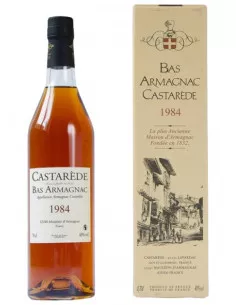
Armagnac
Armagnac is a grape brandy produced in the Pays de Gascogne region of south-west France, between the Adour and Garonne rivers by the foothills of the Pyrenees, where it has been made since at least the 15th century. The terroir here is a varying mixture of sand and clay spread across rolling hills drenched in sunshine during the long summer.
The older sibling of Cognac, Armagnac production dates back to 1411 or even earlier, making it the earliest French spirit we know of. Like Cognac, it has been recognised as an ‘Appellation d’Origine Contrôlée’ (Controlled Appellation of Origin) since 1936. However, it’s not just location that separates the two spirits; the key to understanding the differences between Armagnac and Cognac is to understand the basics of grape growing, distillation and the effect of wood types on spirit maturation.
Grapes: Whilst Cognac is made largely from the Ugni Blanc grape, Armagnac utilizes several grape varieties - Ugni Blanc represents 55% of production but is then followed by Baco Blanc/Baco 22A (35%), Folle Blanche (5%) and Colombard (5%). A further six varieties can legally be used, but are extremely rare.
Armagnac has three distinct winegrowing regions:
- Bas Armagnac: Highly-regarded, creating eaux-de-vie with a distinct bouquet of plums. This represents the majority of Armagnac production.
- Armagnac-Ténarèze: Produces richly perfumed spirits with a robust character.
- Haut Armagnac: Despite covering the largest area, this terroir has fewer vineyards and therefore the smallest yield of the three regions.
Distillation: The still used in Cognac is based on double distillation and the eau-de-vie has an average alcoholic volume of 72% when leaving the still. For Armagnac, column stills are preferred, but the eau-de-vie is only distilled once. By law, the distillation strength can be between 52% and 72.4% but usually leans towards the lower end of this. Once distillation is underway, it carries on 24 hours a day. The period between harvest and the end of winter is known as La Flamme de L’Armagnac, marked by festivals and celebrations all around Gascony. In stark contrast to the production scale and worldwide popularity of Cognac, Armagnac is mainly produced by small-scale growers, with almost a third of production being done by mobile stills that can be driven around the countryside or shared with neighbors. In fact, there are no major Armagnac producers and even the largest firms only put out around 1–2 million bottles per year. Of all French spirits, Armagnac is probably the least industrial.
Maturation: Cognac is aged mainly in French oak casks from the Limousin or Tronçais forests in central France, while Armagnac may choose Gascon oak from the south. Also known as ‘black oak’, this wood is particularly tannic, imparting a deep color and an intense character of dark fruits. Armagnacs can be classified by their age, starting from the 1st of April after the eaux-de-vie were distilled. The age classifications for Armagnac differ slightly from those of Cognac:
- VS: at least one year aging in wood
- VSOP: at least four years
- Napoléon: at least six years
- Hors d’Age, XO: at least 10 years
- Vintage: must be over 10 years and not blended with other vintages.
Note that with vintages, the year on the label indicates the year of the harvest.
The small-scale production of Armagnac means that the result can vary dramatically from distiller to distiller, even within one town or terroir. While the brandy is often bold and robust, it can also be found floral and light, to spicy with notes of leather and incense. The range of flavors found in Armagnac can span a wide spectrum simply because it is such an artisanal product. Made in small quantities by largely unknown producers, this is a spirit that wears its individuality with pride. For the fans of this underrated brandy, its peasant roots and individual rustic varieties are intrinsically tied to its popularity and an innate part of its charm. The connection between the winegrowers, the terroir and the brandy makes this historical spirit one of a kind. Each Armagnac is as unique as the hands that crafted it, and that’s just the way it should be.
Brand
Price
Cognac age
Growth area
Bottle size
ABV
Vintage year
Organic
Grape Varieties
Armagnac age













































